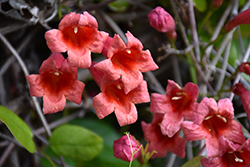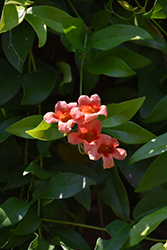It's all about ...
plants

Red Cross Vine
Bignonia capreolata 'Atrosanguinea'
Height: 20 feet
Spread: 24 inches
Sunlight:
![]()
![]()
Hardiness Zone: 7a
Other Names: Red Trumpet-Flower Vine
Description:
Beautiful clusters of purplish-red flowers on this vigorous climbing vine; foliage is evergreen in the south, but otherwise turns reddish purple in fall; the flowers are attractive to hummingbirds and butterflies; needs a sturdy structure for support
Ornamental Features
Red Cross Vine features showy red trumpet-shaped flowers along the branches from late spring to early summer, which emerge from distinctive dark red flower buds. Its glossy oval leaves are dark green in colour. The foliage often turns burgundy in fall.
Landscape Attributes
Red Cross Vine is a multi-stemmed evergreen perennial vine with a twining and trailing habit of growth. Its medium texture blends into the garden, but can always be balanced by a couple of finer or coarser plants for an effective composition.
This plant will require occasional maintenance and upkeep, and should only be pruned after flowering to avoid removing any of the current season's flowers. It is a good choice for attracting bees, butterflies and hummingbirds to your yard. Gardeners should be aware of the following characteristic(s) that may warrant special consideration;
- Spreading
Red Cross Vine is recommended for the following landscape applications;
- Mass Planting
- Hedges/Screening
- General Garden Use
Planting & Growing
Red Cross Vine will grow to be about 20 feet tall at maturity, with a spread of 24 inches. As a climbing vine, it should either be planted near a fence, trellis or other landscape structure where it can be trained to grow upwards on it, or allowed to trail off a retaining wall or slope. Although it is technically a woody plant, this fast-growing plant can be expected to behave as a perennial in our climate if planted outdoors over the winter, usually regrowing from its base (crown) the following year. As such, gardeners should take into consideration that it will perform differently than it would in its native habitat.
This plant does best in full sun to partial shade. It is an amazingly adaptable plant, tolerating both dry conditions and even some standing water. It is not particular as to soil type, but has a definite preference for acidic soils. It is highly tolerant of urban pollution and will even thrive in inner city environments. This is a selection of a native North American species.
This plant is not reliably hardy in our region, and certain restrictions may apply; contact the store for more information.

